Human Resource Performance Management System Analysis Report
VerifiedAdded on 2020/12/09
|15
|3767
|262
Report
AI Summary
This report examines the role of performance management systems within human resource (HR) practices, aiming to understand their impact on organizational success. It begins with an introduction outlining the report's aims, objectives, and key stakeholders, followed by a comprehensive literature review that synthesizes the perspectives of various authors on performance management. The literature review explores different approaches to performance measurement, including comparative, attribute, behavioral, result, and quality approaches, while also discussing the importance of performance appraisal. The report critiques the selected literature, justifying the research choices and evaluating the advantages and disadvantages of each approach. It then proposes a presentation of findings, followed by a conclusion summarizing the key insights and implications of the analysis. The report emphasizes the strategic importance of performance management in retaining employees, motivating them, and achieving organizational goals, highlighting the need for well-established systems that foster employee engagement and contribute to overall business performance. The report also delves into the challenges of implementing performance management systems, such as conflicting objectives and time constraints, and stresses the need for effective training and development programs.
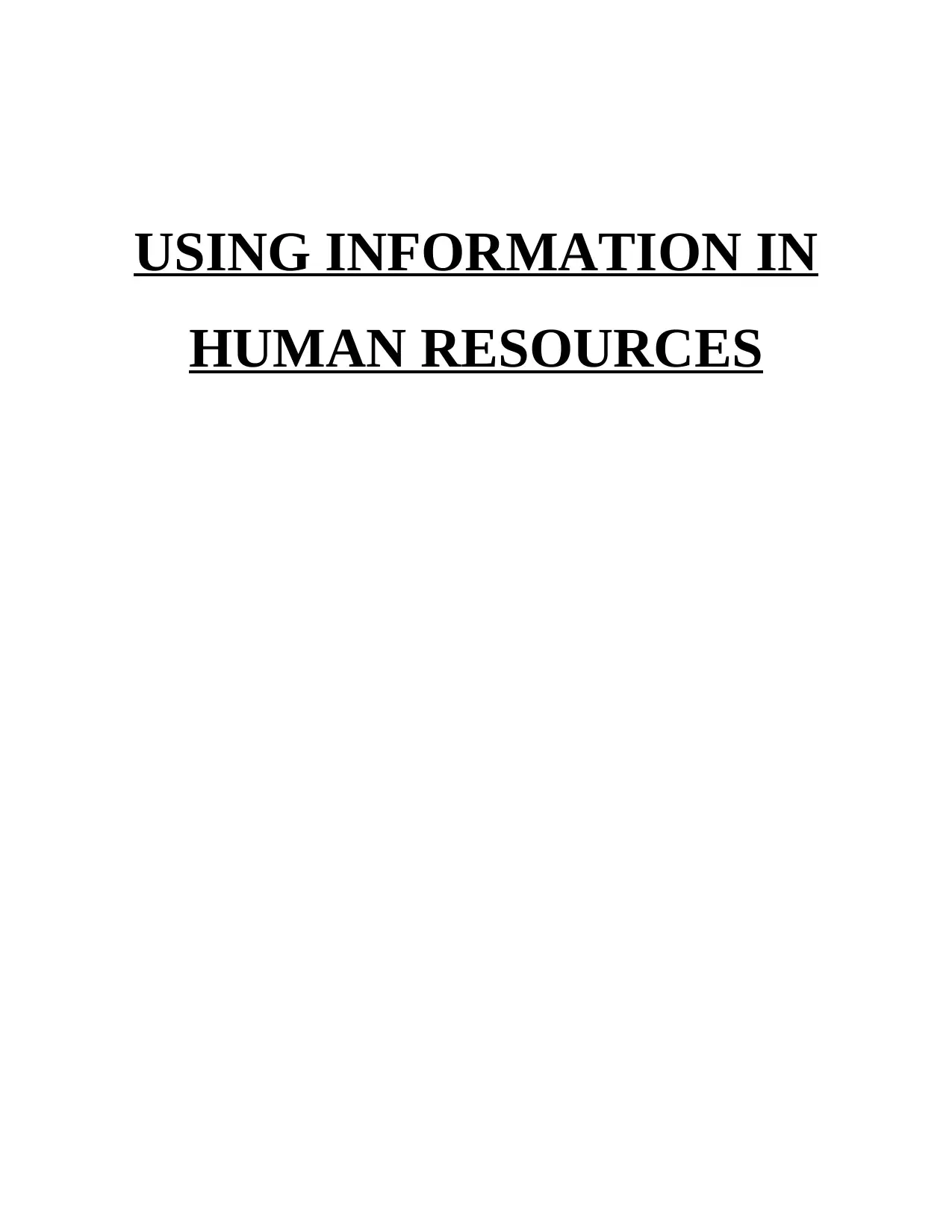
USING INFORMATION IN
HUMAN RESOURCES
HUMAN RESOURCES
Secure Best Marks with AI Grader
Need help grading? Try our AI Grader for instant feedback on your assignments.
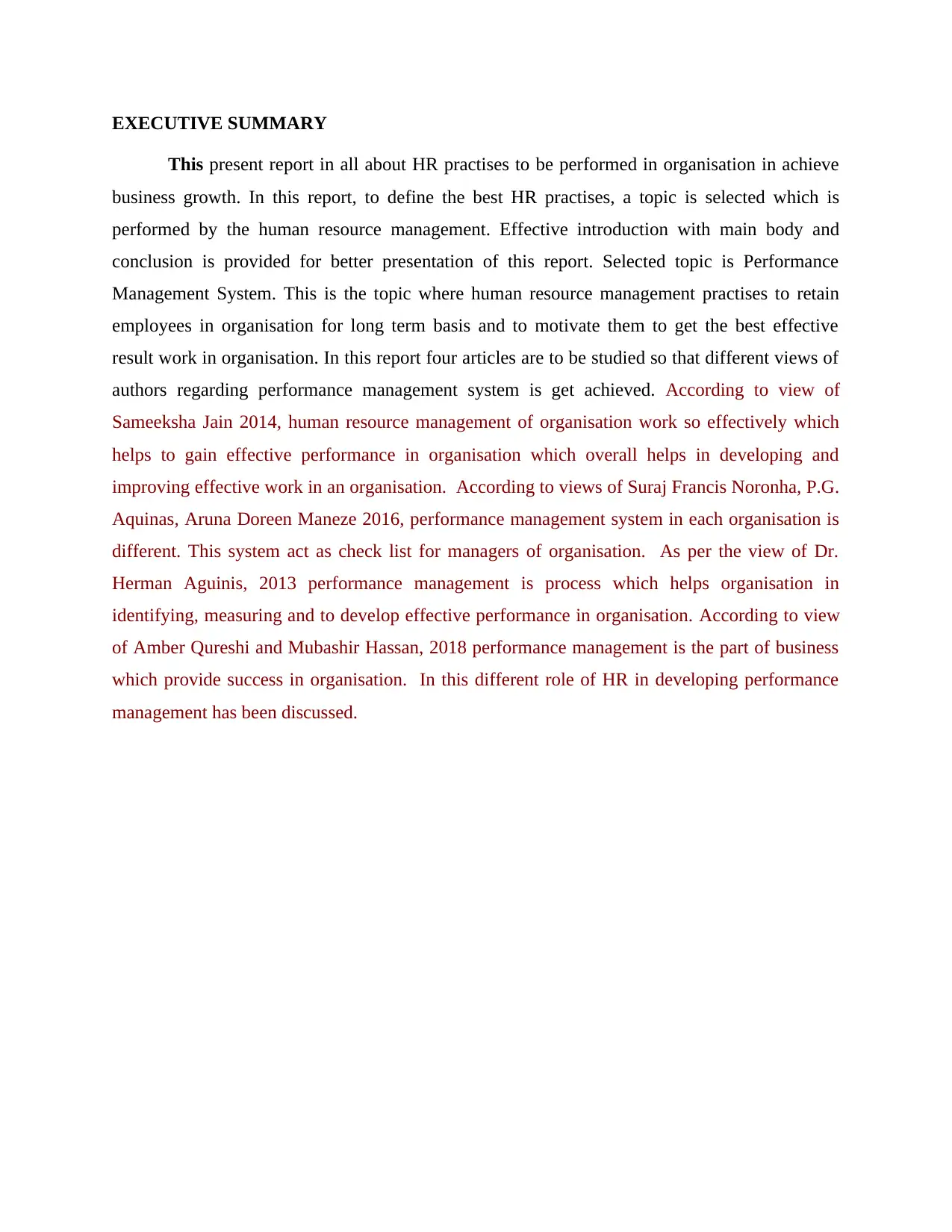
EXECUTIVE SUMMARY
This present report in all about HR practises to be performed in organisation in achieve
business growth. In this report, to define the best HR practises, a topic is selected which is
performed by the human resource management. Effective introduction with main body and
conclusion is provided for better presentation of this report. Selected topic is Performance
Management System. This is the topic where human resource management practises to retain
employees in organisation for long term basis and to motivate them to get the best effective
result work in organisation. In this report four articles are to be studied so that different views of
authors regarding performance management system is get achieved. According to view of
Sameeksha Jain 2014, human resource management of organisation work so effectively which
helps to gain effective performance in organisation which overall helps in developing and
improving effective work in an organisation. According to views of Suraj Francis Noronha, P.G.
Aquinas, Aruna Doreen Maneze 2016, performance management system in each organisation is
different. This system act as check list for managers of organisation. As per the view of Dr.
Herman Aguinis, 2013 performance management is process which helps organisation in
identifying, measuring and to develop effective performance in organisation. According to view
of Amber Qureshi and Mubashir Hassan, 2018 performance management is the part of business
which provide success in organisation. In this different role of HR in developing performance
management has been discussed.
This present report in all about HR practises to be performed in organisation in achieve
business growth. In this report, to define the best HR practises, a topic is selected which is
performed by the human resource management. Effective introduction with main body and
conclusion is provided for better presentation of this report. Selected topic is Performance
Management System. This is the topic where human resource management practises to retain
employees in organisation for long term basis and to motivate them to get the best effective
result work in organisation. In this report four articles are to be studied so that different views of
authors regarding performance management system is get achieved. According to view of
Sameeksha Jain 2014, human resource management of organisation work so effectively which
helps to gain effective performance in organisation which overall helps in developing and
improving effective work in an organisation. According to views of Suraj Francis Noronha, P.G.
Aquinas, Aruna Doreen Maneze 2016, performance management system in each organisation is
different. This system act as check list for managers of organisation. As per the view of Dr.
Herman Aguinis, 2013 performance management is process which helps organisation in
identifying, measuring and to develop effective performance in organisation. According to view
of Amber Qureshi and Mubashir Hassan, 2018 performance management is the part of business
which provide success in organisation. In this different role of HR in developing performance
management has been discussed.
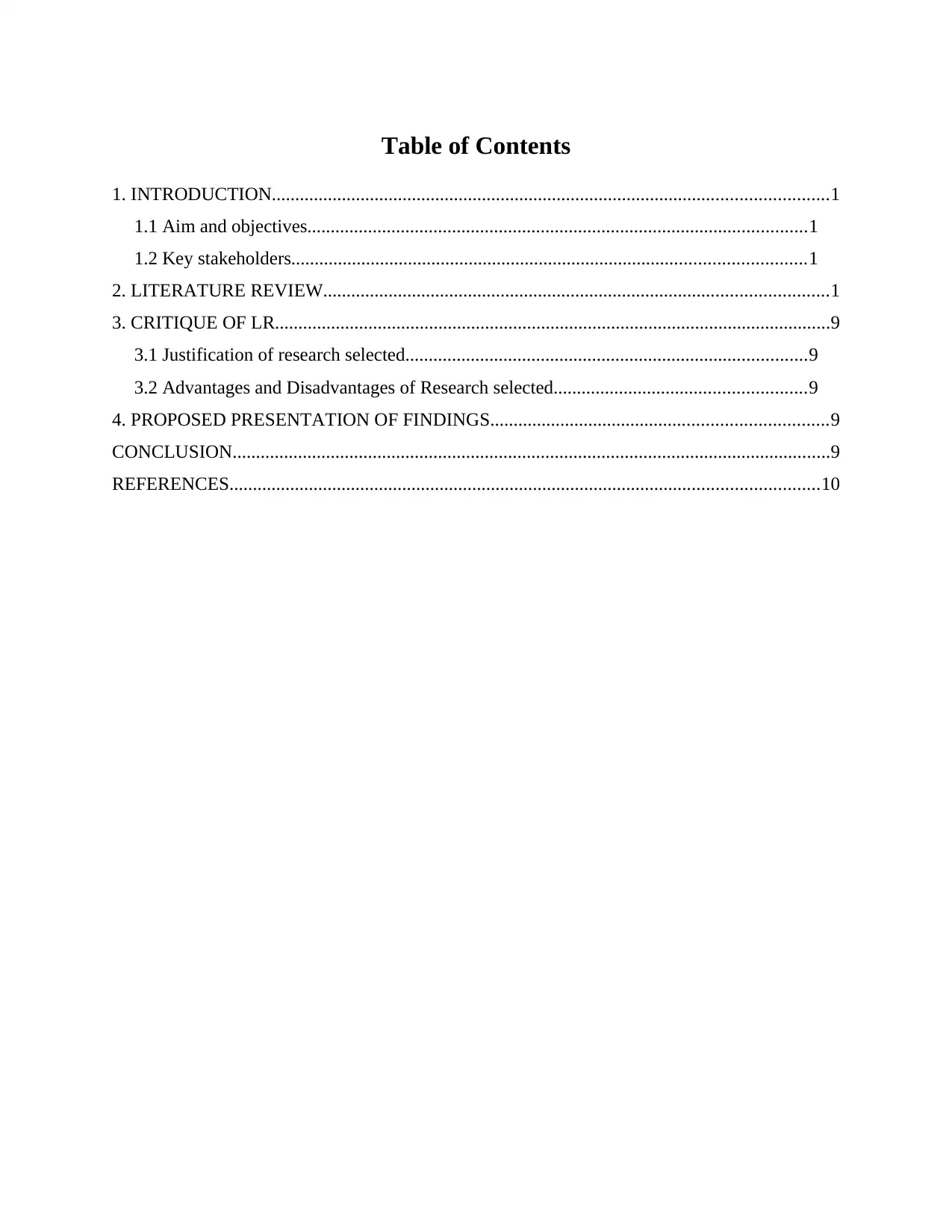
Table of Contents
1. INTRODUCTION.......................................................................................................................1
1.1 Aim and objectives...........................................................................................................1
1.2 Key stakeholders..............................................................................................................1
2. LITERATURE REVIEW............................................................................................................1
3. CRITIQUE OF LR.......................................................................................................................9
3.1 Justification of research selected......................................................................................9
3.2 Advantages and Disadvantages of Research selected......................................................9
4. PROPOSED PRESENTATION OF FINDINGS........................................................................9
CONCLUSION................................................................................................................................9
REFERENCES..............................................................................................................................10
1. INTRODUCTION.......................................................................................................................1
1.1 Aim and objectives...........................................................................................................1
1.2 Key stakeholders..............................................................................................................1
2. LITERATURE REVIEW............................................................................................................1
3. CRITIQUE OF LR.......................................................................................................................9
3.1 Justification of research selected......................................................................................9
3.2 Advantages and Disadvantages of Research selected......................................................9
4. PROPOSED PRESENTATION OF FINDINGS........................................................................9
CONCLUSION................................................................................................................................9
REFERENCES..............................................................................................................................10
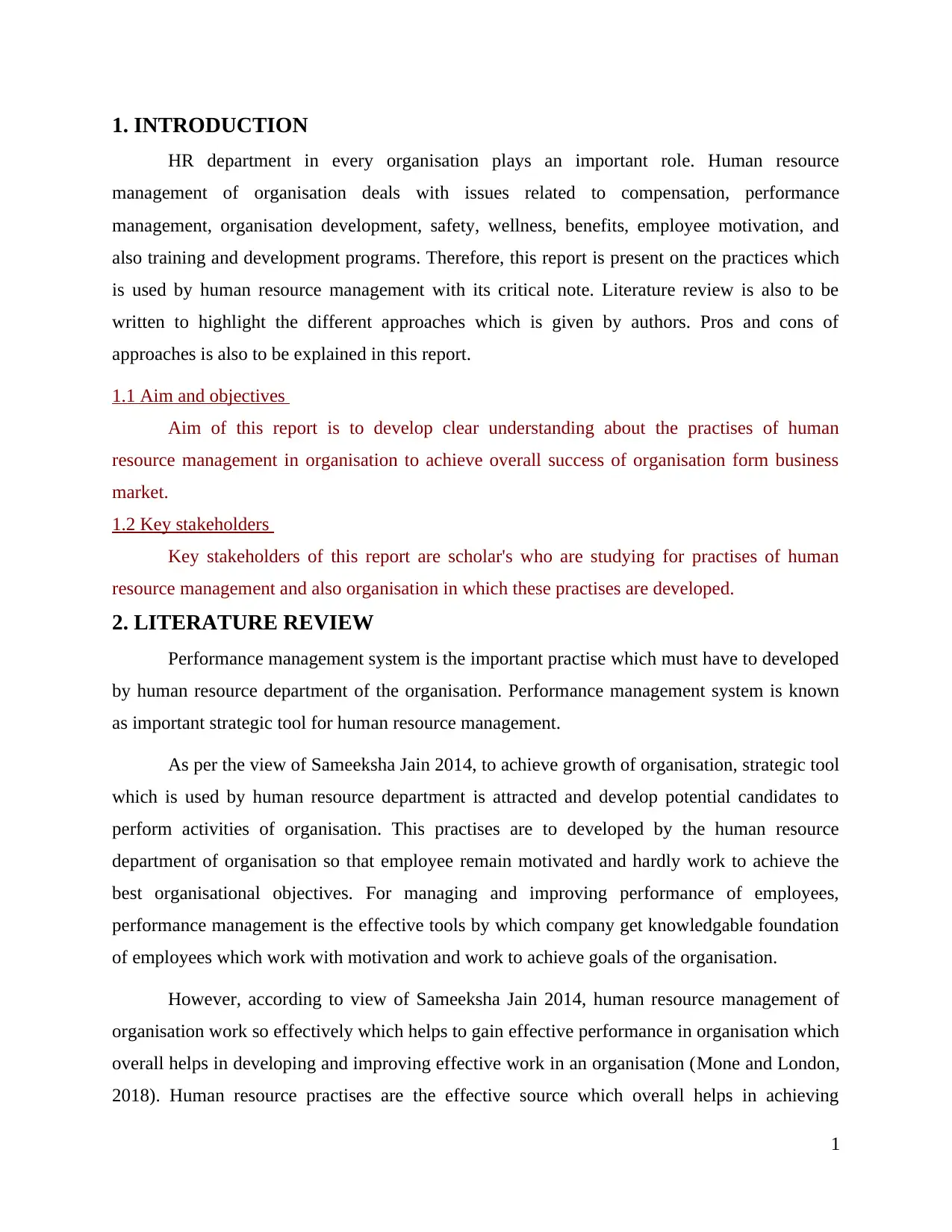
1. INTRODUCTION
HR department in every organisation plays an important role. Human resource
management of organisation deals with issues related to compensation, performance
management, organisation development, safety, wellness, benefits, employee motivation, and
also training and development programs. Therefore, this report is present on the practices which
is used by human resource management with its critical note. Literature review is also to be
written to highlight the different approaches which is given by authors. Pros and cons of
approaches is also to be explained in this report.
1.1 Aim and objectives
Aim of this report is to develop clear understanding about the practises of human
resource management in organisation to achieve overall success of organisation form business
market.
1.2 Key stakeholders
Key stakeholders of this report are scholar's who are studying for practises of human
resource management and also organisation in which these practises are developed.
2. LITERATURE REVIEW
Performance management system is the important practise which must have to developed
by human resource department of the organisation. Performance management system is known
as important strategic tool for human resource management.
As per the view of Sameeksha Jain 2014, to achieve growth of organisation, strategic tool
which is used by human resource department is attracted and develop potential candidates to
perform activities of organisation. This practises are to developed by the human resource
department of organisation so that employee remain motivated and hardly work to achieve the
best organisational objectives. For managing and improving performance of employees,
performance management is the effective tools by which company get knowledgable foundation
of employees which work with motivation and work to achieve goals of the organisation.
However, according to view of Sameeksha Jain 2014, human resource management of
organisation work so effectively which helps to gain effective performance in organisation which
overall helps in developing and improving effective work in an organisation (Mone and London,
2018). Human resource practises are the effective source which overall helps in achieving
1
HR department in every organisation plays an important role. Human resource
management of organisation deals with issues related to compensation, performance
management, organisation development, safety, wellness, benefits, employee motivation, and
also training and development programs. Therefore, this report is present on the practices which
is used by human resource management with its critical note. Literature review is also to be
written to highlight the different approaches which is given by authors. Pros and cons of
approaches is also to be explained in this report.
1.1 Aim and objectives
Aim of this report is to develop clear understanding about the practises of human
resource management in organisation to achieve overall success of organisation form business
market.
1.2 Key stakeholders
Key stakeholders of this report are scholar's who are studying for practises of human
resource management and also organisation in which these practises are developed.
2. LITERATURE REVIEW
Performance management system is the important practise which must have to developed
by human resource department of the organisation. Performance management system is known
as important strategic tool for human resource management.
As per the view of Sameeksha Jain 2014, to achieve growth of organisation, strategic tool
which is used by human resource department is attracted and develop potential candidates to
perform activities of organisation. This practises are to developed by the human resource
department of organisation so that employee remain motivated and hardly work to achieve the
best organisational objectives. For managing and improving performance of employees,
performance management is the effective tools by which company get knowledgable foundation
of employees which work with motivation and work to achieve goals of the organisation.
However, according to view of Sameeksha Jain 2014, human resource management of
organisation work so effectively which helps to gain effective performance in organisation which
overall helps in developing and improving effective work in an organisation (Mone and London,
2018). Human resource practises are the effective source which overall helps in achieving
1
Secure Best Marks with AI Grader
Need help grading? Try our AI Grader for instant feedback on your assignments.
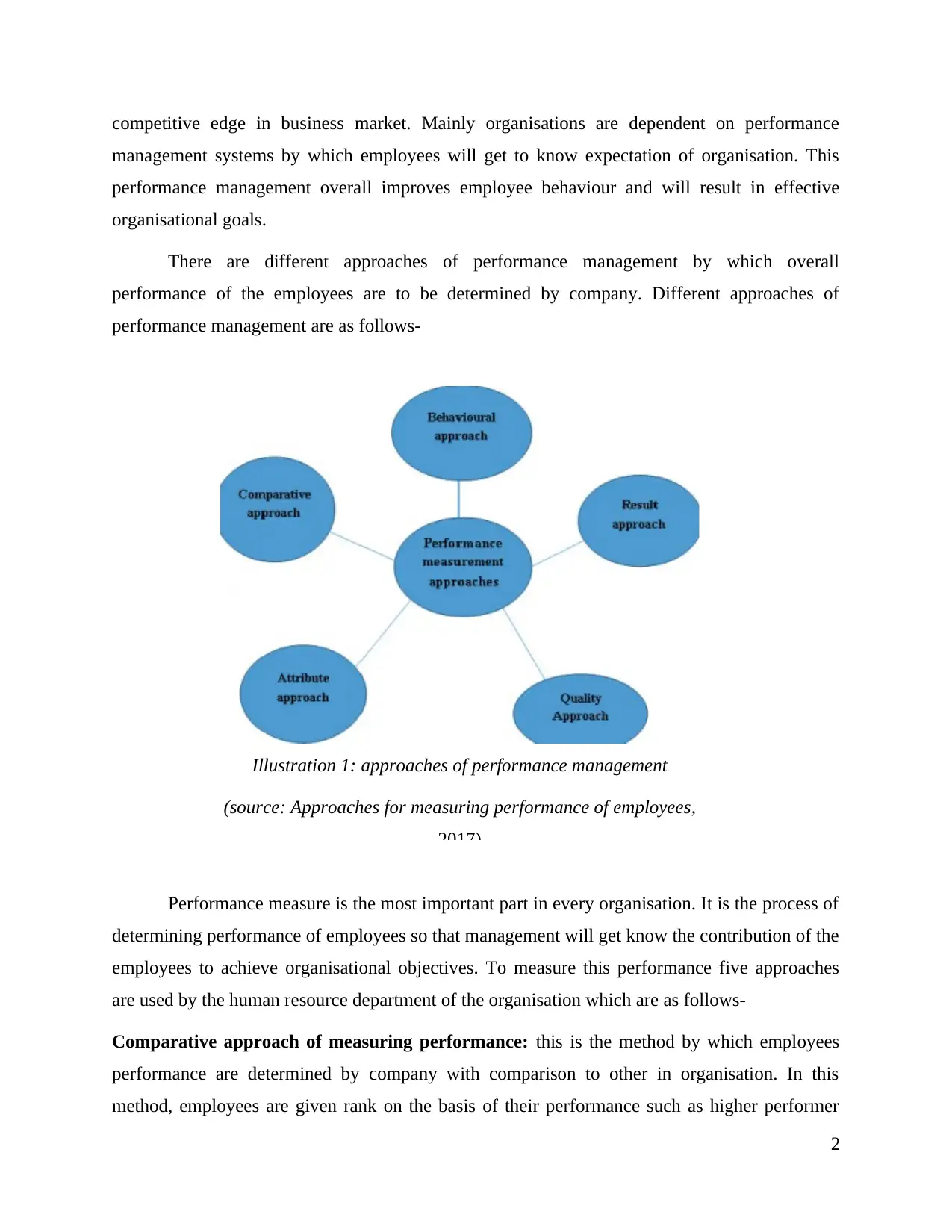
competitive edge in business market. Mainly organisations are dependent on performance
management systems by which employees will get to know expectation of organisation. This
performance management overall improves employee behaviour and will result in effective
organisational goals.
There are different approaches of performance management by which overall
performance of the employees are to be determined by company. Different approaches of
performance management are as follows-
Performance measure is the most important part in every organisation. It is the process of
determining performance of employees so that management will get know the contribution of the
employees to achieve organisational objectives. To measure this performance five approaches
are used by the human resource department of the organisation which are as follows-
Comparative approach of measuring performance: this is the method by which employees
performance are determined by company with comparison to other in organisation. In this
method, employees are given rank on the basis of their performance such as higher performer
2
Illustration 1: approaches of performance management
(source: Approaches for measuring performance of employees,
2017)
management systems by which employees will get to know expectation of organisation. This
performance management overall improves employee behaviour and will result in effective
organisational goals.
There are different approaches of performance management by which overall
performance of the employees are to be determined by company. Different approaches of
performance management are as follows-
Performance measure is the most important part in every organisation. It is the process of
determining performance of employees so that management will get know the contribution of the
employees to achieve organisational objectives. To measure this performance five approaches
are used by the human resource department of the organisation which are as follows-
Comparative approach of measuring performance: this is the method by which employees
performance are determined by company with comparison to other in organisation. In this
method, employees are given rank on the basis of their performance such as higher performer
2
Illustration 1: approaches of performance management
(source: Approaches for measuring performance of employees,
2017)
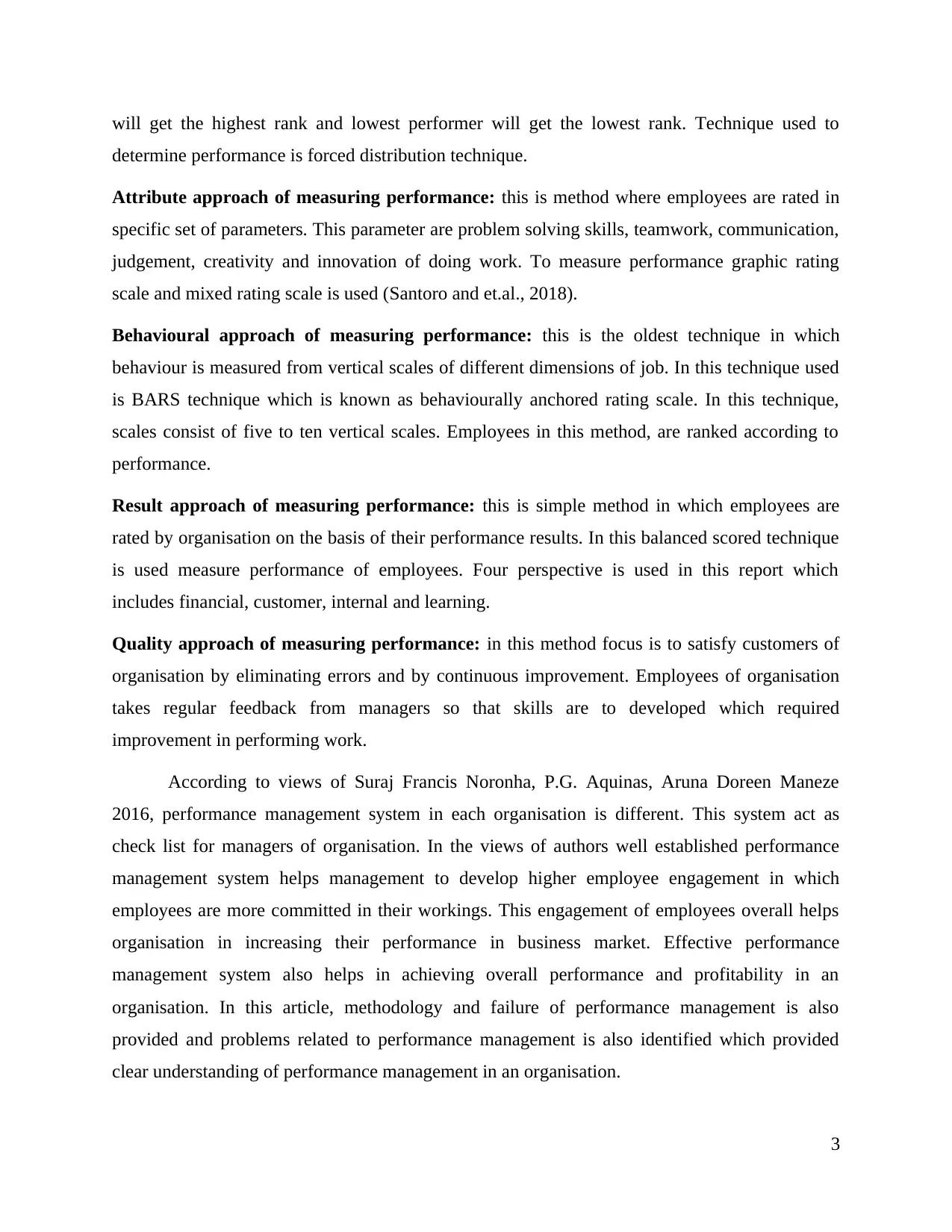
will get the highest rank and lowest performer will get the lowest rank. Technique used to
determine performance is forced distribution technique.
Attribute approach of measuring performance: this is method where employees are rated in
specific set of parameters. This parameter are problem solving skills, teamwork, communication,
judgement, creativity and innovation of doing work. To measure performance graphic rating
scale and mixed rating scale is used (Santoro and et.al., 2018).
Behavioural approach of measuring performance: this is the oldest technique in which
behaviour is measured from vertical scales of different dimensions of job. In this technique used
is BARS technique which is known as behaviourally anchored rating scale. In this technique,
scales consist of five to ten vertical scales. Employees in this method, are ranked according to
performance.
Result approach of measuring performance: this is simple method in which employees are
rated by organisation on the basis of their performance results. In this balanced scored technique
is used measure performance of employees. Four perspective is used in this report which
includes financial, customer, internal and learning.
Quality approach of measuring performance: in this method focus is to satisfy customers of
organisation by eliminating errors and by continuous improvement. Employees of organisation
takes regular feedback from managers so that skills are to developed which required
improvement in performing work.
According to views of Suraj Francis Noronha, P.G. Aquinas, Aruna Doreen Maneze
2016, performance management system in each organisation is different. This system act as
check list for managers of organisation. In the views of authors well established performance
management system helps management to develop higher employee engagement in which
employees are more committed in their workings. This engagement of employees overall helps
organisation in increasing their performance in business market. Effective performance
management system also helps in achieving overall performance and profitability in an
organisation. In this article, methodology and failure of performance management is also
provided and problems related to performance management is also identified which provided
clear understanding of performance management in an organisation.
3
determine performance is forced distribution technique.
Attribute approach of measuring performance: this is method where employees are rated in
specific set of parameters. This parameter are problem solving skills, teamwork, communication,
judgement, creativity and innovation of doing work. To measure performance graphic rating
scale and mixed rating scale is used (Santoro and et.al., 2018).
Behavioural approach of measuring performance: this is the oldest technique in which
behaviour is measured from vertical scales of different dimensions of job. In this technique used
is BARS technique which is known as behaviourally anchored rating scale. In this technique,
scales consist of five to ten vertical scales. Employees in this method, are ranked according to
performance.
Result approach of measuring performance: this is simple method in which employees are
rated by organisation on the basis of their performance results. In this balanced scored technique
is used measure performance of employees. Four perspective is used in this report which
includes financial, customer, internal and learning.
Quality approach of measuring performance: in this method focus is to satisfy customers of
organisation by eliminating errors and by continuous improvement. Employees of organisation
takes regular feedback from managers so that skills are to developed which required
improvement in performing work.
According to views of Suraj Francis Noronha, P.G. Aquinas, Aruna Doreen Maneze
2016, performance management system in each organisation is different. This system act as
check list for managers of organisation. In the views of authors well established performance
management system helps management to develop higher employee engagement in which
employees are more committed in their workings. This engagement of employees overall helps
organisation in increasing their performance in business market. Effective performance
management system also helps in achieving overall performance and profitability in an
organisation. In this article, methodology and failure of performance management is also
provided and problems related to performance management is also identified which provided
clear understanding of performance management in an organisation.
3
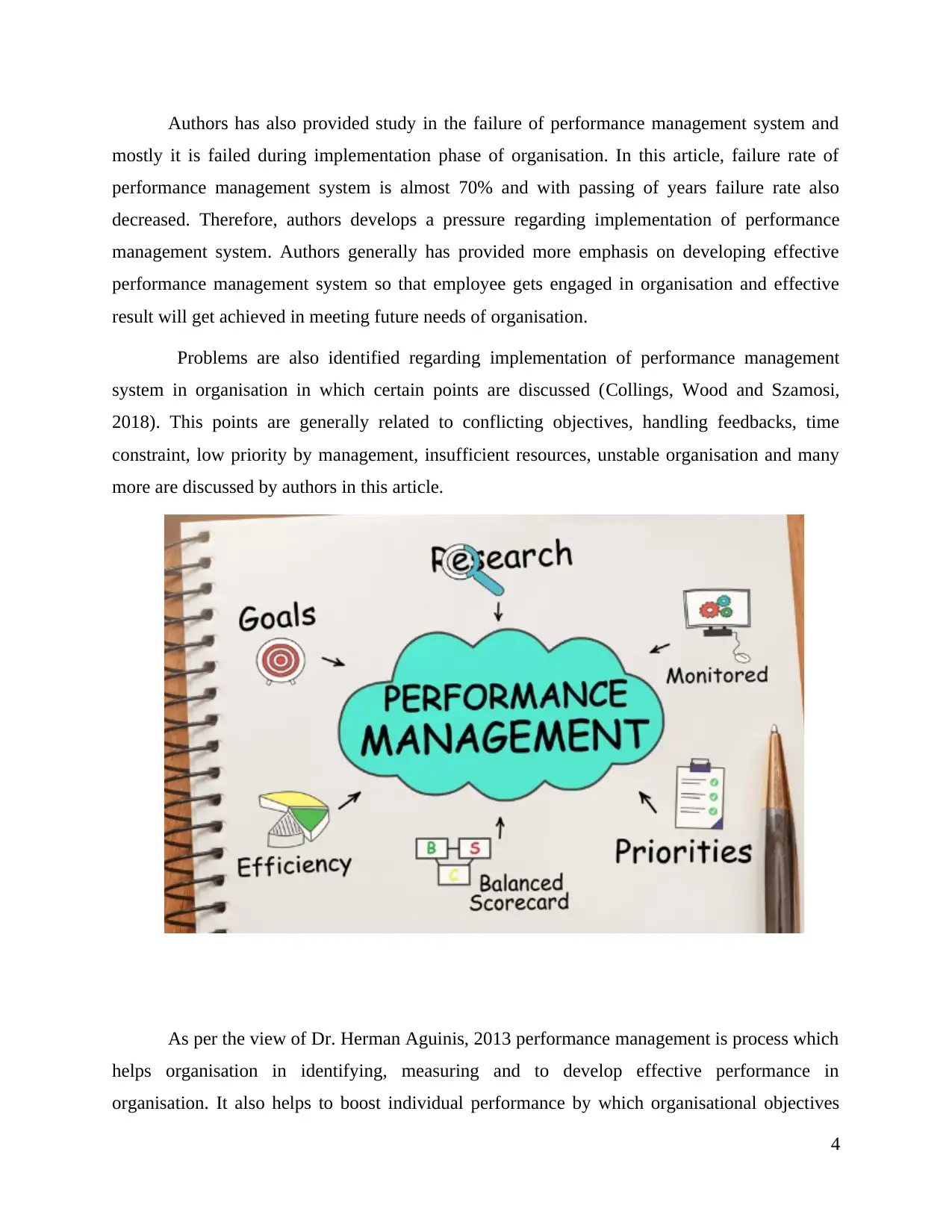
Authors has also provided study in the failure of performance management system and
mostly it is failed during implementation phase of organisation. In this article, failure rate of
performance management system is almost 70% and with passing of years failure rate also
decreased. Therefore, authors develops a pressure regarding implementation of performance
management system. Authors generally has provided more emphasis on developing effective
performance management system so that employee gets engaged in organisation and effective
result will get achieved in meeting future needs of organisation.
Problems are also identified regarding implementation of performance management
system in organisation in which certain points are discussed (Collings, Wood and Szamosi,
2018). This points are generally related to conflicting objectives, handling feedbacks, time
constraint, low priority by management, insufficient resources, unstable organisation and many
more are discussed by authors in this article.
As per the view of Dr. Herman Aguinis, 2013 performance management is process which
helps organisation in identifying, measuring and to develop effective performance in
organisation. It also helps to boost individual performance by which organisational objectives
4
mostly it is failed during implementation phase of organisation. In this article, failure rate of
performance management system is almost 70% and with passing of years failure rate also
decreased. Therefore, authors develops a pressure regarding implementation of performance
management system. Authors generally has provided more emphasis on developing effective
performance management system so that employee gets engaged in organisation and effective
result will get achieved in meeting future needs of organisation.
Problems are also identified regarding implementation of performance management
system in organisation in which certain points are discussed (Collings, Wood and Szamosi,
2018). This points are generally related to conflicting objectives, handling feedbacks, time
constraint, low priority by management, insufficient resources, unstable organisation and many
more are discussed by authors in this article.
As per the view of Dr. Herman Aguinis, 2013 performance management is process which
helps organisation in identifying, measuring and to develop effective performance in
organisation. It also helps to boost individual performance by which organisational objectives
4
Paraphrase This Document
Need a fresh take? Get an instant paraphrase of this document with our AI Paraphraser
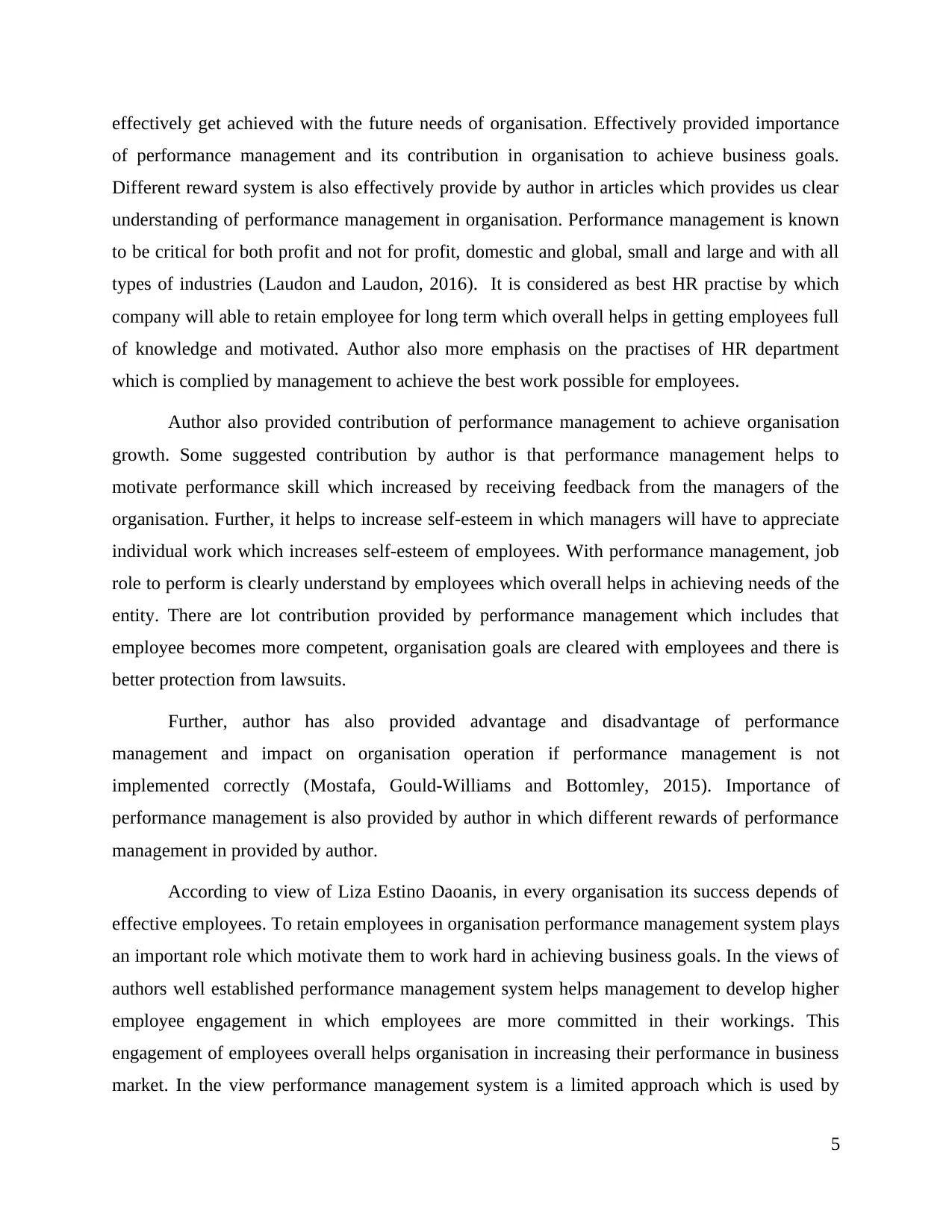
effectively get achieved with the future needs of organisation. Effectively provided importance
of performance management and its contribution in organisation to achieve business goals.
Different reward system is also effectively provide by author in articles which provides us clear
understanding of performance management in organisation. Performance management is known
to be critical for both profit and not for profit, domestic and global, small and large and with all
types of industries (Laudon and Laudon, 2016). It is considered as best HR practise by which
company will able to retain employee for long term which overall helps in getting employees full
of knowledge and motivated. Author also more emphasis on the practises of HR department
which is complied by management to achieve the best work possible for employees.
Author also provided contribution of performance management to achieve organisation
growth. Some suggested contribution by author is that performance management helps to
motivate performance skill which increased by receiving feedback from the managers of the
organisation. Further, it helps to increase self-esteem in which managers will have to appreciate
individual work which increases self-esteem of employees. With performance management, job
role to perform is clearly understand by employees which overall helps in achieving needs of the
entity. There are lot contribution provided by performance management which includes that
employee becomes more competent, organisation goals are cleared with employees and there is
better protection from lawsuits.
Further, author has also provided advantage and disadvantage of performance
management and impact on organisation operation if performance management is not
implemented correctly (Mostafa, Gould‐Williams and Bottomley, 2015). Importance of
performance management is also provided by author in which different rewards of performance
management in provided by author.
According to view of Liza Estino Daoanis, in every organisation its success depends of
effective employees. To retain employees in organisation performance management system plays
an important role which motivate them to work hard in achieving business goals. In the views of
authors well established performance management system helps management to develop higher
employee engagement in which employees are more committed in their workings. This
engagement of employees overall helps organisation in increasing their performance in business
market. In the view performance management system is a limited approach which is used by
5
of performance management and its contribution in organisation to achieve business goals.
Different reward system is also effectively provide by author in articles which provides us clear
understanding of performance management in organisation. Performance management is known
to be critical for both profit and not for profit, domestic and global, small and large and with all
types of industries (Laudon and Laudon, 2016). It is considered as best HR practise by which
company will able to retain employee for long term which overall helps in getting employees full
of knowledge and motivated. Author also more emphasis on the practises of HR department
which is complied by management to achieve the best work possible for employees.
Author also provided contribution of performance management to achieve organisation
growth. Some suggested contribution by author is that performance management helps to
motivate performance skill which increased by receiving feedback from the managers of the
organisation. Further, it helps to increase self-esteem in which managers will have to appreciate
individual work which increases self-esteem of employees. With performance management, job
role to perform is clearly understand by employees which overall helps in achieving needs of the
entity. There are lot contribution provided by performance management which includes that
employee becomes more competent, organisation goals are cleared with employees and there is
better protection from lawsuits.
Further, author has also provided advantage and disadvantage of performance
management and impact on organisation operation if performance management is not
implemented correctly (Mostafa, Gould‐Williams and Bottomley, 2015). Importance of
performance management is also provided by author in which different rewards of performance
management in provided by author.
According to view of Liza Estino Daoanis, in every organisation its success depends of
effective employees. To retain employees in organisation performance management system plays
an important role which motivate them to work hard in achieving business goals. In the views of
authors well established performance management system helps management to develop higher
employee engagement in which employees are more committed in their workings. This
engagement of employees overall helps organisation in increasing their performance in business
market. In the view performance management system is a limited approach which is used by
5
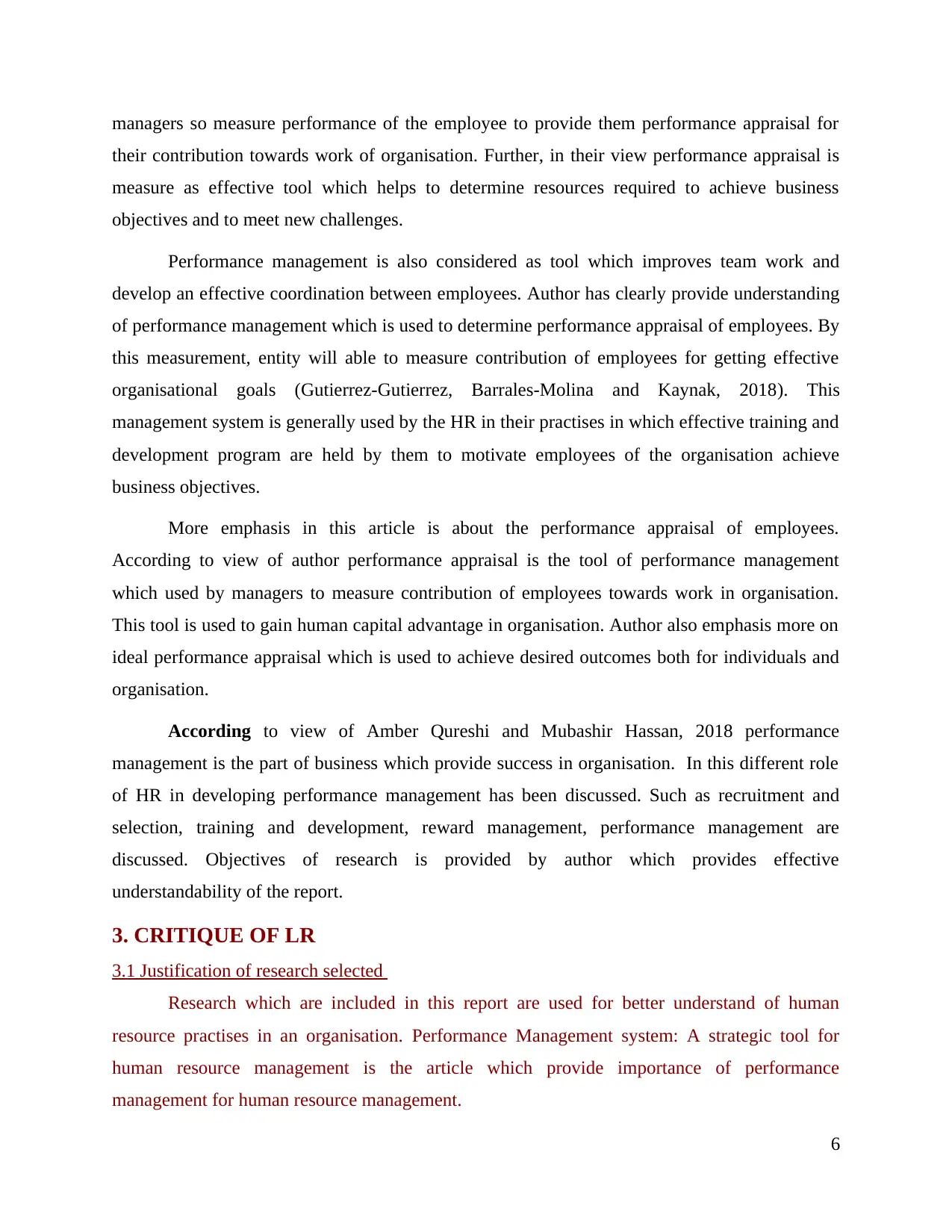
managers so measure performance of the employee to provide them performance appraisal for
their contribution towards work of organisation. Further, in their view performance appraisal is
measure as effective tool which helps to determine resources required to achieve business
objectives and to meet new challenges.
Performance management is also considered as tool which improves team work and
develop an effective coordination between employees. Author has clearly provide understanding
of performance management which is used to determine performance appraisal of employees. By
this measurement, entity will able to measure contribution of employees for getting effective
organisational goals (Gutierrez-Gutierrez, Barrales-Molina and Kaynak, 2018). This
management system is generally used by the HR in their practises in which effective training and
development program are held by them to motivate employees of the organisation achieve
business objectives.
More emphasis in this article is about the performance appraisal of employees.
According to view of author performance appraisal is the tool of performance management
which used by managers to measure contribution of employees towards work in organisation.
This tool is used to gain human capital advantage in organisation. Author also emphasis more on
ideal performance appraisal which is used to achieve desired outcomes both for individuals and
organisation.
According to view of Amber Qureshi and Mubashir Hassan, 2018 performance
management is the part of business which provide success in organisation. In this different role
of HR in developing performance management has been discussed. Such as recruitment and
selection, training and development, reward management, performance management are
discussed. Objectives of research is provided by author which provides effective
understandability of the report.
3. CRITIQUE OF LR
3.1 Justification of research selected
Research which are included in this report are used for better understand of human
resource practises in an organisation. Performance Management system: A strategic tool for
human resource management is the article which provide importance of performance
management for human resource management.
6
their contribution towards work of organisation. Further, in their view performance appraisal is
measure as effective tool which helps to determine resources required to achieve business
objectives and to meet new challenges.
Performance management is also considered as tool which improves team work and
develop an effective coordination between employees. Author has clearly provide understanding
of performance management which is used to determine performance appraisal of employees. By
this measurement, entity will able to measure contribution of employees for getting effective
organisational goals (Gutierrez-Gutierrez, Barrales-Molina and Kaynak, 2018). This
management system is generally used by the HR in their practises in which effective training and
development program are held by them to motivate employees of the organisation achieve
business objectives.
More emphasis in this article is about the performance appraisal of employees.
According to view of author performance appraisal is the tool of performance management
which used by managers to measure contribution of employees towards work in organisation.
This tool is used to gain human capital advantage in organisation. Author also emphasis more on
ideal performance appraisal which is used to achieve desired outcomes both for individuals and
organisation.
According to view of Amber Qureshi and Mubashir Hassan, 2018 performance
management is the part of business which provide success in organisation. In this different role
of HR in developing performance management has been discussed. Such as recruitment and
selection, training and development, reward management, performance management are
discussed. Objectives of research is provided by author which provides effective
understandability of the report.
3. CRITIQUE OF LR
3.1 Justification of research selected
Research which are included in this report are used for better understand of human
resource practises in an organisation. Performance Management system: A strategic tool for
human resource management is the article which provide importance of performance
management for human resource management.
6
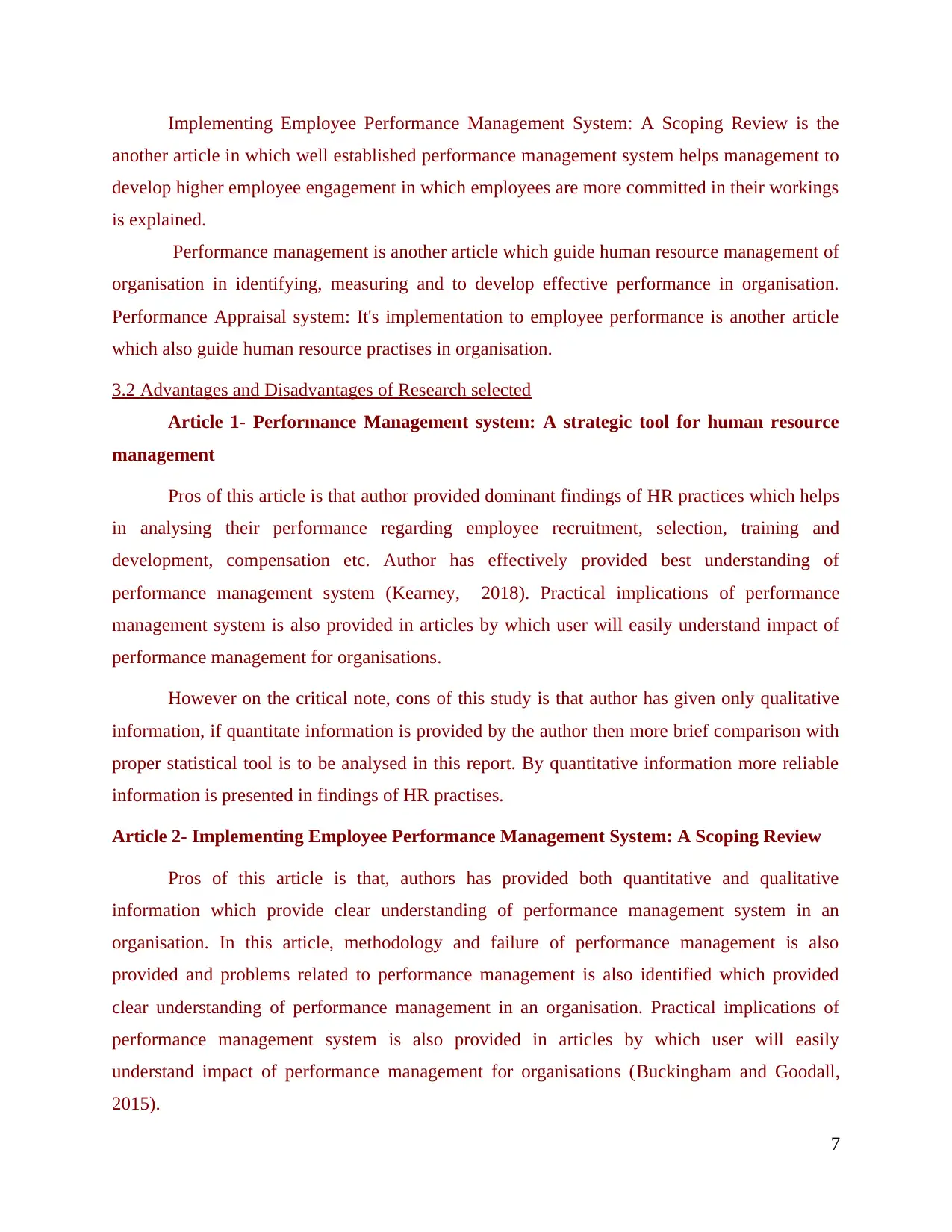
Implementing Employee Performance Management System: A Scoping Review is the
another article in which well established performance management system helps management to
develop higher employee engagement in which employees are more committed in their workings
is explained.
Performance management is another article which guide human resource management of
organisation in identifying, measuring and to develop effective performance in organisation.
Performance Appraisal system: It's implementation to employee performance is another article
which also guide human resource practises in organisation.
3.2 Advantages and Disadvantages of Research selected
Article 1- Performance Management system: A strategic tool for human resource
management
Pros of this article is that author provided dominant findings of HR practices which helps
in analysing their performance regarding employee recruitment, selection, training and
development, compensation etc. Author has effectively provided best understanding of
performance management system (Kearney, 2018). Practical implications of performance
management system is also provided in articles by which user will easily understand impact of
performance management for organisations.
However on the critical note, cons of this study is that author has given only qualitative
information, if quantitate information is provided by the author then more brief comparison with
proper statistical tool is to be analysed in this report. By quantitative information more reliable
information is presented in findings of HR practises.
Article 2- Implementing Employee Performance Management System: A Scoping Review
Pros of this article is that, authors has provided both quantitative and qualitative
information which provide clear understanding of performance management system in an
organisation. In this article, methodology and failure of performance management is also
provided and problems related to performance management is also identified which provided
clear understanding of performance management in an organisation. Practical implications of
performance management system is also provided in articles by which user will easily
understand impact of performance management for organisations (Buckingham and Goodall,
2015).
7
another article in which well established performance management system helps management to
develop higher employee engagement in which employees are more committed in their workings
is explained.
Performance management is another article which guide human resource management of
organisation in identifying, measuring and to develop effective performance in organisation.
Performance Appraisal system: It's implementation to employee performance is another article
which also guide human resource practises in organisation.
3.2 Advantages and Disadvantages of Research selected
Article 1- Performance Management system: A strategic tool for human resource
management
Pros of this article is that author provided dominant findings of HR practices which helps
in analysing their performance regarding employee recruitment, selection, training and
development, compensation etc. Author has effectively provided best understanding of
performance management system (Kearney, 2018). Practical implications of performance
management system is also provided in articles by which user will easily understand impact of
performance management for organisations.
However on the critical note, cons of this study is that author has given only qualitative
information, if quantitate information is provided by the author then more brief comparison with
proper statistical tool is to be analysed in this report. By quantitative information more reliable
information is presented in findings of HR practises.
Article 2- Implementing Employee Performance Management System: A Scoping Review
Pros of this article is that, authors has provided both quantitative and qualitative
information which provide clear understanding of performance management system in an
organisation. In this article, methodology and failure of performance management is also
provided and problems related to performance management is also identified which provided
clear understanding of performance management in an organisation. Practical implications of
performance management system is also provided in articles by which user will easily
understand impact of performance management for organisations (Buckingham and Goodall,
2015).
7
Secure Best Marks with AI Grader
Need help grading? Try our AI Grader for instant feedback on your assignments.
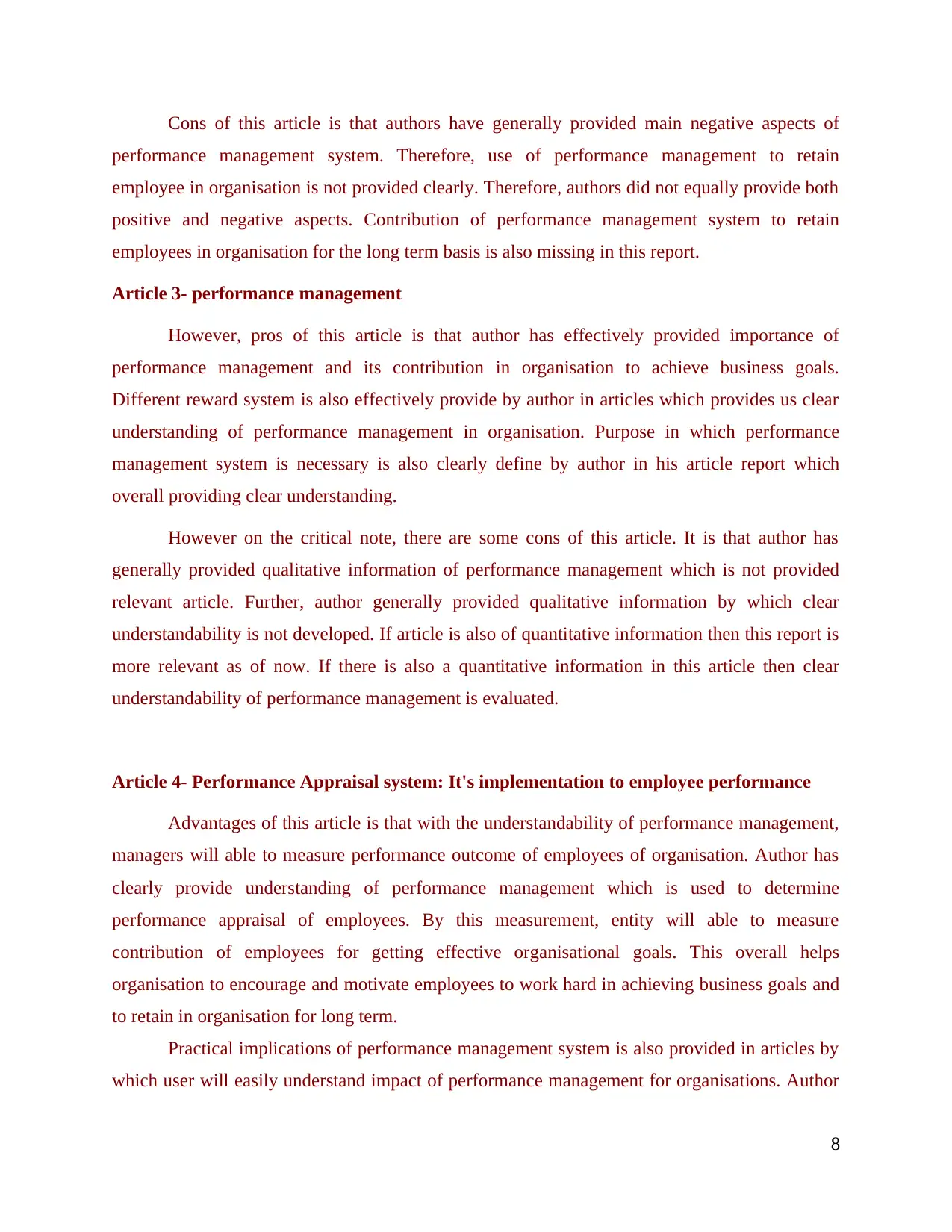
Cons of this article is that authors have generally provided main negative aspects of
performance management system. Therefore, use of performance management to retain
employee in organisation is not provided clearly. Therefore, authors did not equally provide both
positive and negative aspects. Contribution of performance management system to retain
employees in organisation for the long term basis is also missing in this report.
Article 3- performance management
However, pros of this article is that author has effectively provided importance of
performance management and its contribution in organisation to achieve business goals.
Different reward system is also effectively provide by author in articles which provides us clear
understanding of performance management in organisation. Purpose in which performance
management system is necessary is also clearly define by author in his article report which
overall providing clear understanding.
However on the critical note, there are some cons of this article. It is that author has
generally provided qualitative information of performance management which is not provided
relevant article. Further, author generally provided qualitative information by which clear
understandability is not developed. If article is also of quantitative information then this report is
more relevant as of now. If there is also a quantitative information in this article then clear
understandability of performance management is evaluated.
Article 4- Performance Appraisal system: It's implementation to employee performance
Advantages of this article is that with the understandability of performance management,
managers will able to measure performance outcome of employees of organisation. Author has
clearly provide understanding of performance management which is used to determine
performance appraisal of employees. By this measurement, entity will able to measure
contribution of employees for getting effective organisational goals. This overall helps
organisation to encourage and motivate employees to work hard in achieving business goals and
to retain in organisation for long term.
Practical implications of performance management system is also provided in articles by
which user will easily understand impact of performance management for organisations. Author
8
performance management system. Therefore, use of performance management to retain
employee in organisation is not provided clearly. Therefore, authors did not equally provide both
positive and negative aspects. Contribution of performance management system to retain
employees in organisation for the long term basis is also missing in this report.
Article 3- performance management
However, pros of this article is that author has effectively provided importance of
performance management and its contribution in organisation to achieve business goals.
Different reward system is also effectively provide by author in articles which provides us clear
understanding of performance management in organisation. Purpose in which performance
management system is necessary is also clearly define by author in his article report which
overall providing clear understanding.
However on the critical note, there are some cons of this article. It is that author has
generally provided qualitative information of performance management which is not provided
relevant article. Further, author generally provided qualitative information by which clear
understandability is not developed. If article is also of quantitative information then this report is
more relevant as of now. If there is also a quantitative information in this article then clear
understandability of performance management is evaluated.
Article 4- Performance Appraisal system: It's implementation to employee performance
Advantages of this article is that with the understandability of performance management,
managers will able to measure performance outcome of employees of organisation. Author has
clearly provide understanding of performance management which is used to determine
performance appraisal of employees. By this measurement, entity will able to measure
contribution of employees for getting effective organisational goals. This overall helps
organisation to encourage and motivate employees to work hard in achieving business goals and
to retain in organisation for long term.
Practical implications of performance management system is also provided in articles by
which user will easily understand impact of performance management for organisations. Author
8
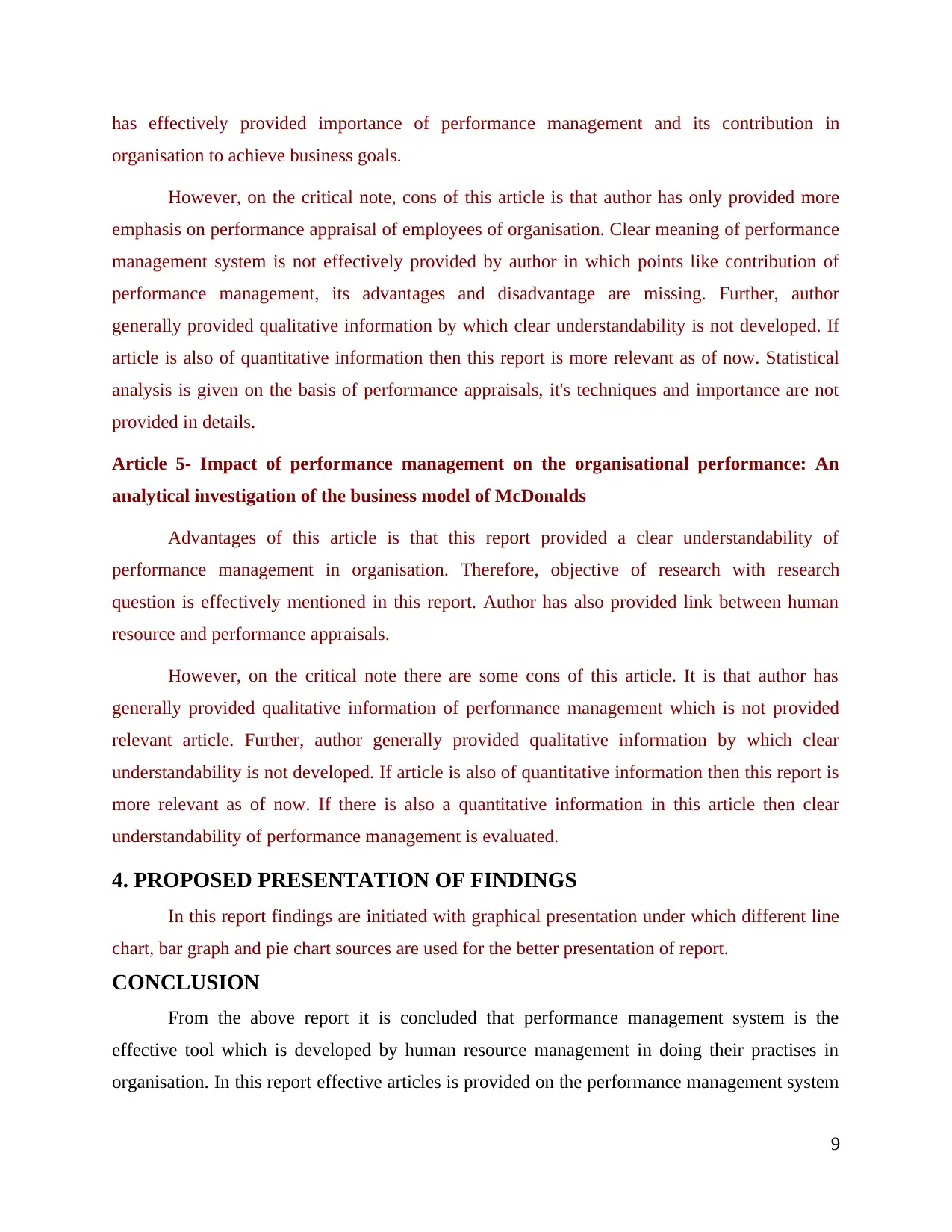
has effectively provided importance of performance management and its contribution in
organisation to achieve business goals.
However, on the critical note, cons of this article is that author has only provided more
emphasis on performance appraisal of employees of organisation. Clear meaning of performance
management system is not effectively provided by author in which points like contribution of
performance management, its advantages and disadvantage are missing. Further, author
generally provided qualitative information by which clear understandability is not developed. If
article is also of quantitative information then this report is more relevant as of now. Statistical
analysis is given on the basis of performance appraisals, it's techniques and importance are not
provided in details.
Article 5- Impact of performance management on the organisational performance: An
analytical investigation of the business model of McDonalds
Advantages of this article is that this report provided a clear understandability of
performance management in organisation. Therefore, objective of research with research
question is effectively mentioned in this report. Author has also provided link between human
resource and performance appraisals.
However, on the critical note there are some cons of this article. It is that author has
generally provided qualitative information of performance management which is not provided
relevant article. Further, author generally provided qualitative information by which clear
understandability is not developed. If article is also of quantitative information then this report is
more relevant as of now. If there is also a quantitative information in this article then clear
understandability of performance management is evaluated.
4. PROPOSED PRESENTATION OF FINDINGS
In this report findings are initiated with graphical presentation under which different line
chart, bar graph and pie chart sources are used for the better presentation of report.
CONCLUSION
From the above report it is concluded that performance management system is the
effective tool which is developed by human resource management in doing their practises in
organisation. In this report effective articles is provided on the performance management system
9
organisation to achieve business goals.
However, on the critical note, cons of this article is that author has only provided more
emphasis on performance appraisal of employees of organisation. Clear meaning of performance
management system is not effectively provided by author in which points like contribution of
performance management, its advantages and disadvantage are missing. Further, author
generally provided qualitative information by which clear understandability is not developed. If
article is also of quantitative information then this report is more relevant as of now. Statistical
analysis is given on the basis of performance appraisals, it's techniques and importance are not
provided in details.
Article 5- Impact of performance management on the organisational performance: An
analytical investigation of the business model of McDonalds
Advantages of this article is that this report provided a clear understandability of
performance management in organisation. Therefore, objective of research with research
question is effectively mentioned in this report. Author has also provided link between human
resource and performance appraisals.
However, on the critical note there are some cons of this article. It is that author has
generally provided qualitative information of performance management which is not provided
relevant article. Further, author generally provided qualitative information by which clear
understandability is not developed. If article is also of quantitative information then this report is
more relevant as of now. If there is also a quantitative information in this article then clear
understandability of performance management is evaluated.
4. PROPOSED PRESENTATION OF FINDINGS
In this report findings are initiated with graphical presentation under which different line
chart, bar graph and pie chart sources are used for the better presentation of report.
CONCLUSION
From the above report it is concluded that performance management system is the
effective tool which is developed by human resource management in doing their practises in
organisation. In this report effective articles is provided on the performance management system
9
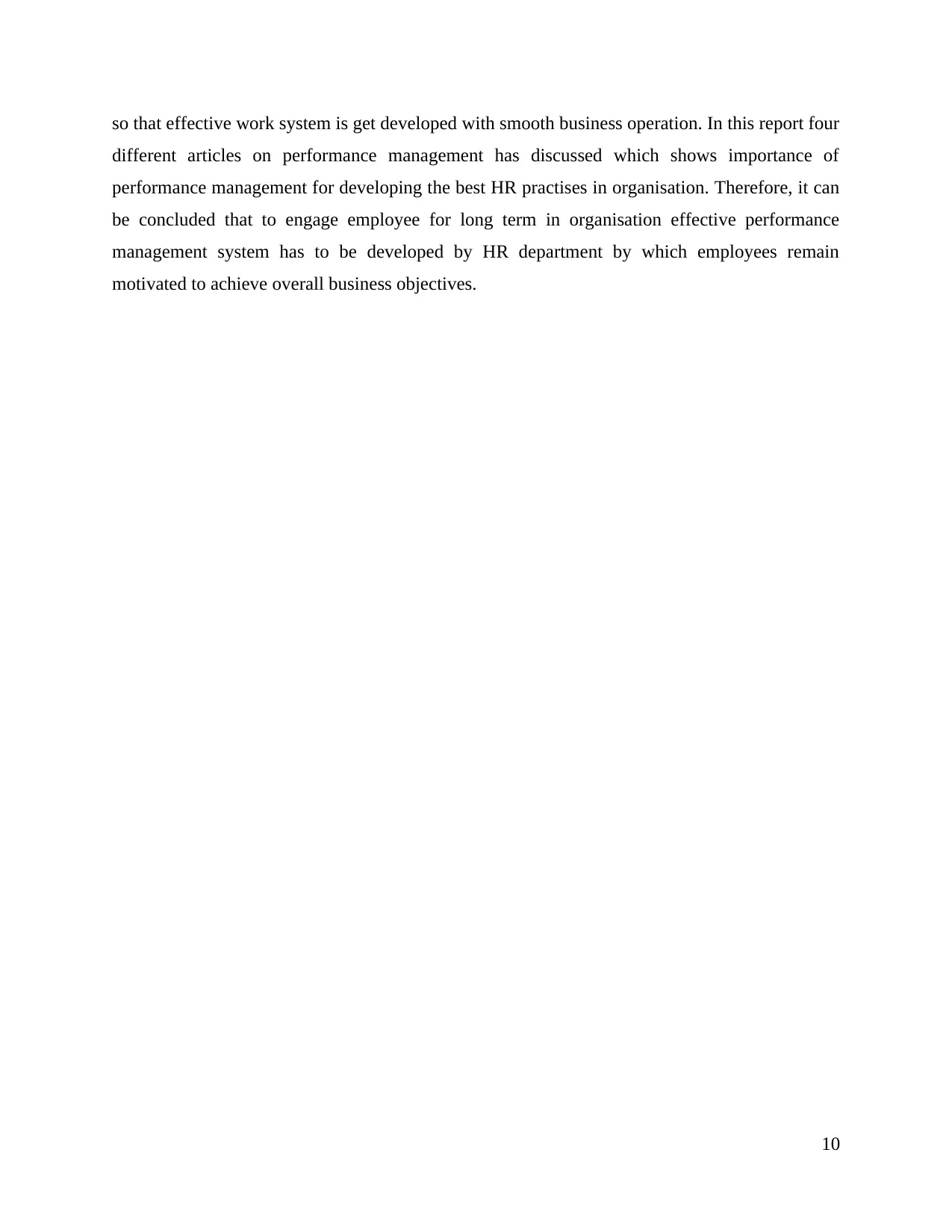
so that effective work system is get developed with smooth business operation. In this report four
different articles on performance management has discussed which shows importance of
performance management for developing the best HR practises in organisation. Therefore, it can
be concluded that to engage employee for long term in organisation effective performance
management system has to be developed by HR department by which employees remain
motivated to achieve overall business objectives.
10
different articles on performance management has discussed which shows importance of
performance management for developing the best HR practises in organisation. Therefore, it can
be concluded that to engage employee for long term in organisation effective performance
management system has to be developed by HR department by which employees remain
motivated to achieve overall business objectives.
10
Paraphrase This Document
Need a fresh take? Get an instant paraphrase of this document with our AI Paraphraser
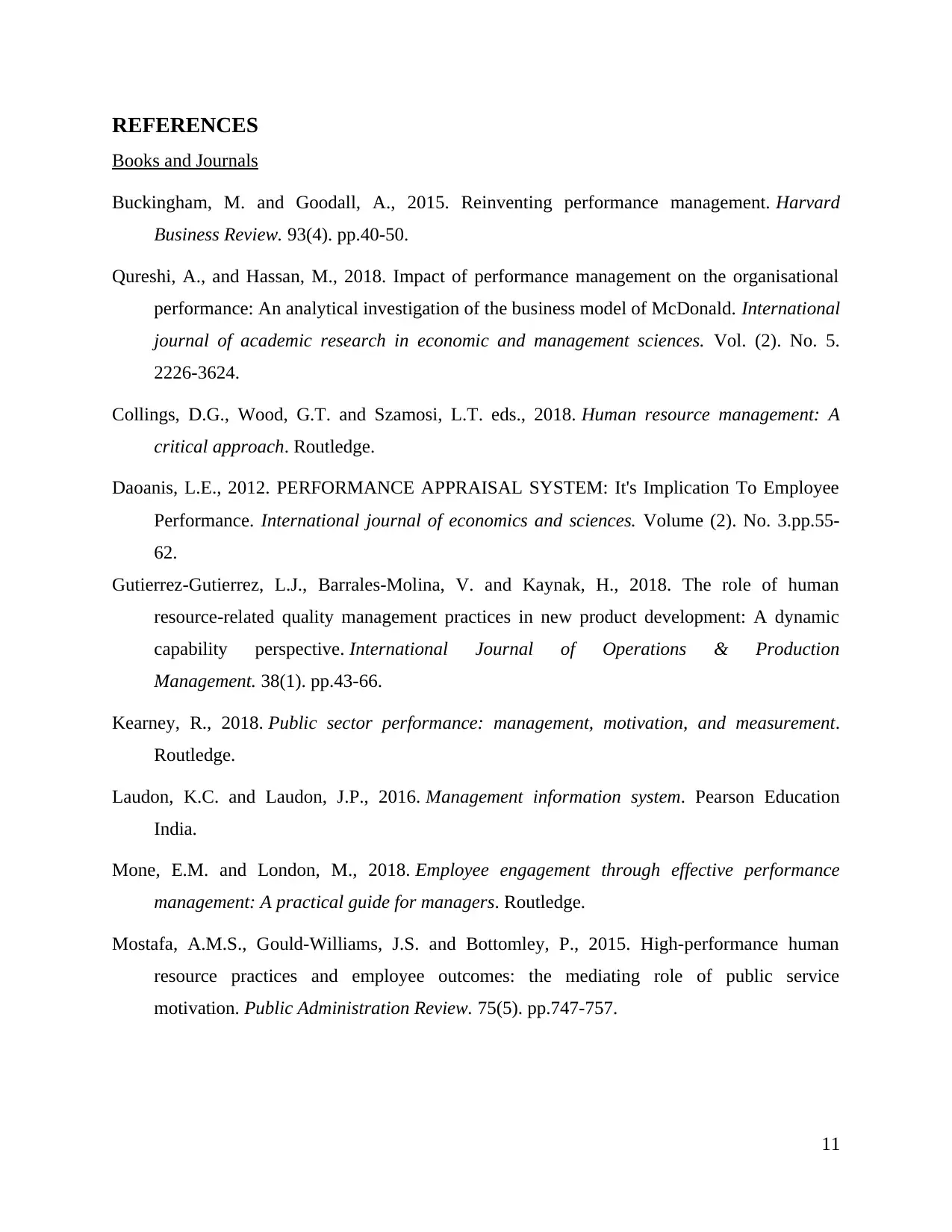
REFERENCES
Books and Journals
Buckingham, M. and Goodall, A., 2015. Reinventing performance management. Harvard
Business Review. 93(4). pp.40-50.
Qureshi, A., and Hassan, M., 2018. Impact of performance management on the organisational
performance: An analytical investigation of the business model of McDonald. International
journal of academic research in economic and management sciences. Vol. (2). No. 5.
2226-3624.
Collings, D.G., Wood, G.T. and Szamosi, L.T. eds., 2018. Human resource management: A
critical approach. Routledge.
Daoanis, L.E., 2012. PERFORMANCE APPRAISAL SYSTEM: It's Implication To Employee
Performance. International journal of economics and sciences. Volume (2). No. 3.pp.55-
62.
Gutierrez-Gutierrez, L.J., Barrales-Molina, V. and Kaynak, H., 2018. The role of human
resource-related quality management practices in new product development: A dynamic
capability perspective. International Journal of Operations & Production
Management. 38(1). pp.43-66.
Kearney, R., 2018. Public sector performance: management, motivation, and measurement.
Routledge.
Laudon, K.C. and Laudon, J.P., 2016. Management information system. Pearson Education
India.
Mone, E.M. and London, M., 2018. Employee engagement through effective performance
management: A practical guide for managers. Routledge.
Mostafa, A.M.S., Gould‐Williams, J.S. and Bottomley, P., 2015. High‐performance human
resource practices and employee outcomes: the mediating role of public service
motivation. Public Administration Review. 75(5). pp.747-757.
11
Books and Journals
Buckingham, M. and Goodall, A., 2015. Reinventing performance management. Harvard
Business Review. 93(4). pp.40-50.
Qureshi, A., and Hassan, M., 2018. Impact of performance management on the organisational
performance: An analytical investigation of the business model of McDonald. International
journal of academic research in economic and management sciences. Vol. (2). No. 5.
2226-3624.
Collings, D.G., Wood, G.T. and Szamosi, L.T. eds., 2018. Human resource management: A
critical approach. Routledge.
Daoanis, L.E., 2012. PERFORMANCE APPRAISAL SYSTEM: It's Implication To Employee
Performance. International journal of economics and sciences. Volume (2). No. 3.pp.55-
62.
Gutierrez-Gutierrez, L.J., Barrales-Molina, V. and Kaynak, H., 2018. The role of human
resource-related quality management practices in new product development: A dynamic
capability perspective. International Journal of Operations & Production
Management. 38(1). pp.43-66.
Kearney, R., 2018. Public sector performance: management, motivation, and measurement.
Routledge.
Laudon, K.C. and Laudon, J.P., 2016. Management information system. Pearson Education
India.
Mone, E.M. and London, M., 2018. Employee engagement through effective performance
management: A practical guide for managers. Routledge.
Mostafa, A.M.S., Gould‐Williams, J.S. and Bottomley, P., 2015. High‐performance human
resource practices and employee outcomes: the mediating role of public service
motivation. Public Administration Review. 75(5). pp.747-757.
11
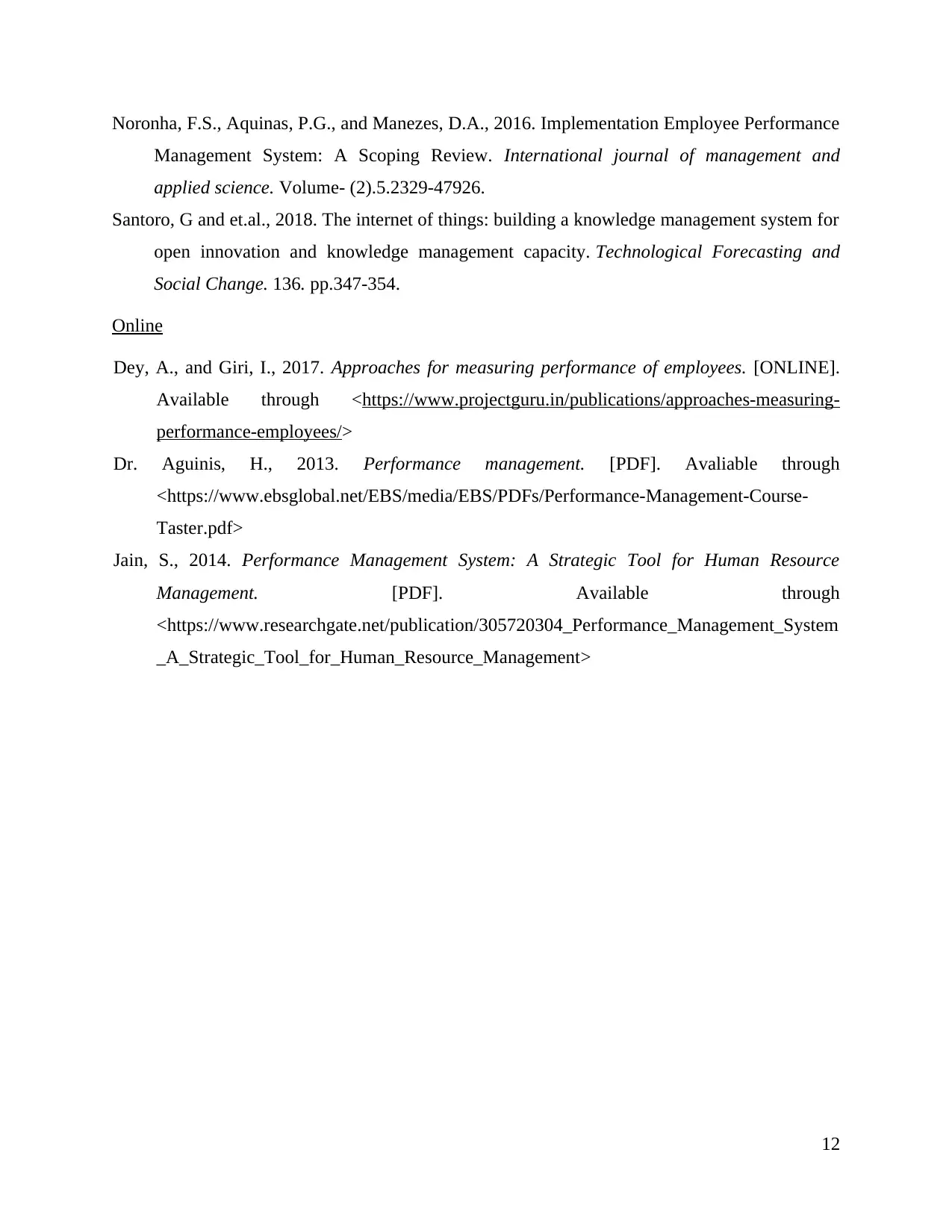
Noronha, F.S., Aquinas, P.G., and Manezes, D.A., 2016. Implementation Employee Performance
Management System: A Scoping Review. International journal of management and
applied science. Volume- (2).5.2329-47926.
Santoro, G and et.al., 2018. The internet of things: building a knowledge management system for
open innovation and knowledge management capacity. Technological Forecasting and
Social Change. 136. pp.347-354.
Online
Dey, A., and Giri, I., 2017. Approaches for measuring performance of employees. [ONLINE].
Available through <https://www.projectguru.in/publications/approaches-measuring-
performance-employees/>
Dr. Aguinis, H., 2013. Performance management. [PDF]. Avaliable through
<https://www.ebsglobal.net/EBS/media/EBS/PDFs/Performance-Management-Course-
Taster.pdf>
Jain, S., 2014. Performance Management System: A Strategic Tool for Human Resource
Management. [PDF]. Available through
<https://www.researchgate.net/publication/305720304_Performance_Management_System
_A_Strategic_Tool_for_Human_Resource_Management>
12
Management System: A Scoping Review. International journal of management and
applied science. Volume- (2).5.2329-47926.
Santoro, G and et.al., 2018. The internet of things: building a knowledge management system for
open innovation and knowledge management capacity. Technological Forecasting and
Social Change. 136. pp.347-354.
Online
Dey, A., and Giri, I., 2017. Approaches for measuring performance of employees. [ONLINE].
Available through <https://www.projectguru.in/publications/approaches-measuring-
performance-employees/>
Dr. Aguinis, H., 2013. Performance management. [PDF]. Avaliable through
<https://www.ebsglobal.net/EBS/media/EBS/PDFs/Performance-Management-Course-
Taster.pdf>
Jain, S., 2014. Performance Management System: A Strategic Tool for Human Resource
Management. [PDF]. Available through
<https://www.researchgate.net/publication/305720304_Performance_Management_System
_A_Strategic_Tool_for_Human_Resource_Management>
12
1 out of 15
Related Documents
Your All-in-One AI-Powered Toolkit for Academic Success.
+13062052269
info@desklib.com
Available 24*7 on WhatsApp / Email
![[object Object]](/_next/static/media/star-bottom.7253800d.svg)
Unlock your academic potential
© 2024 | Zucol Services PVT LTD | All rights reserved.





